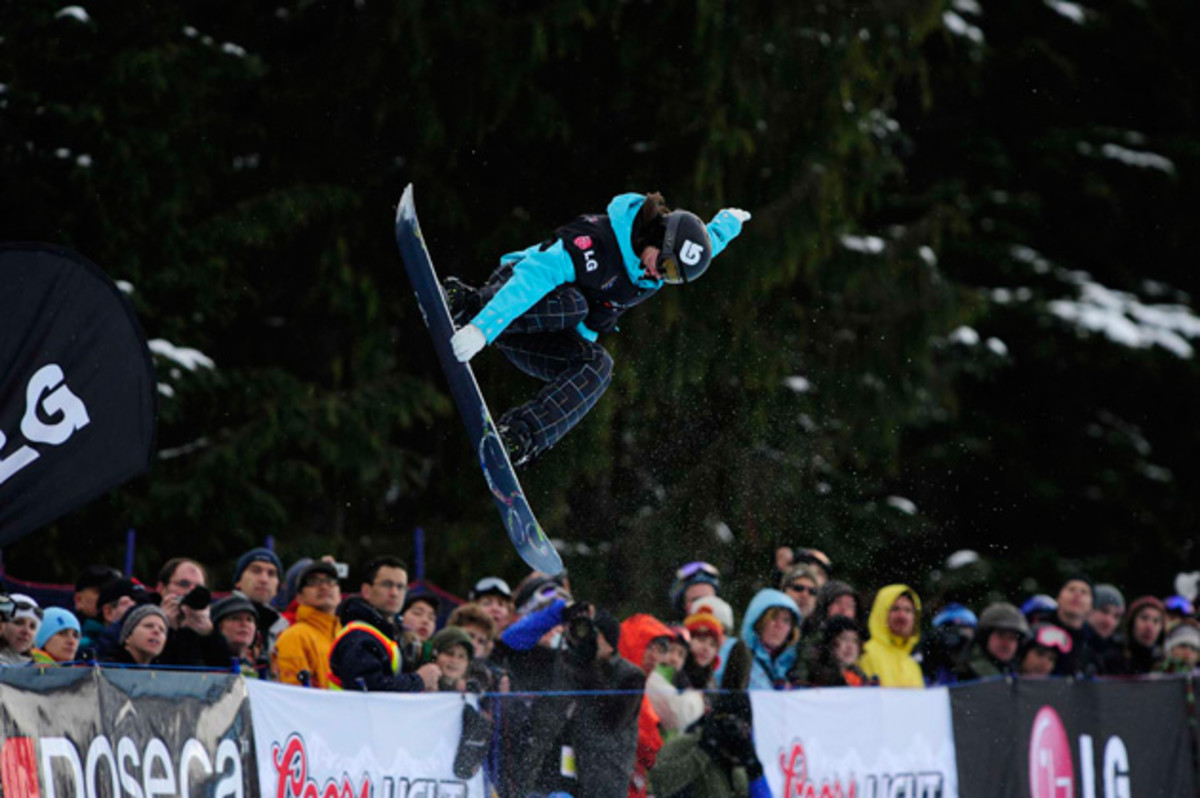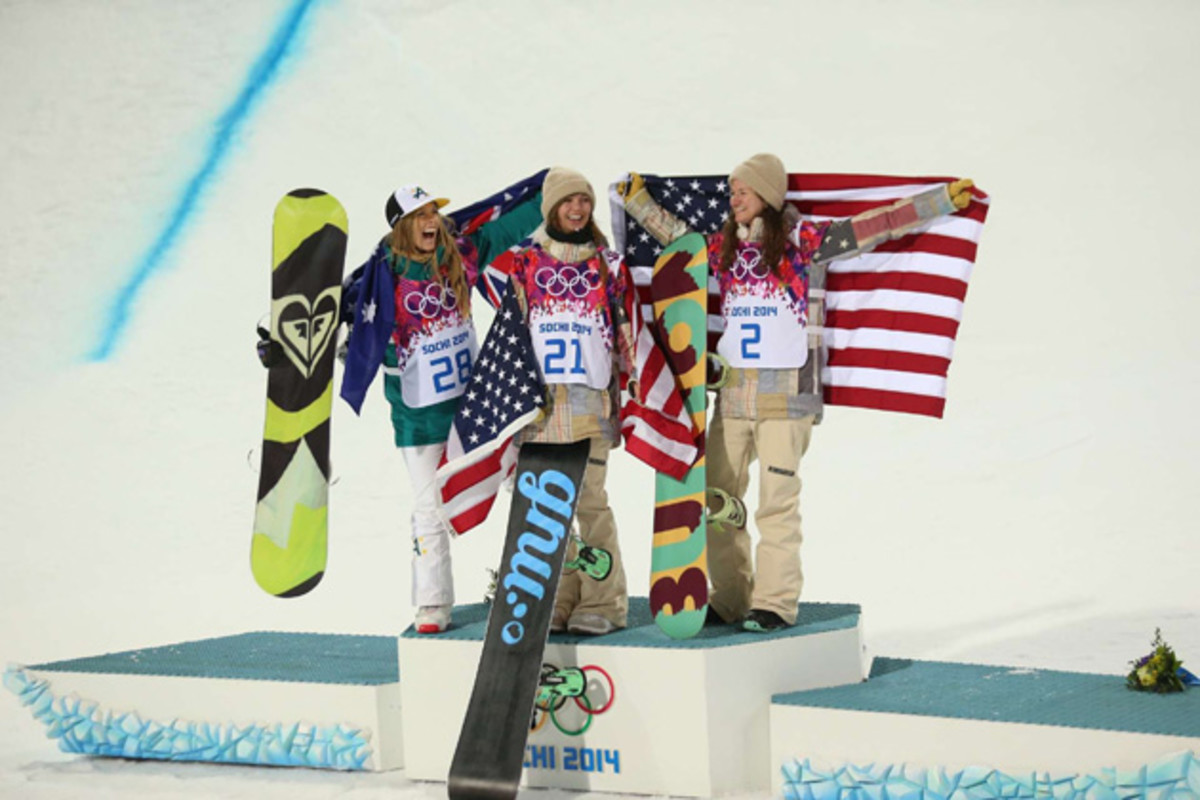Kelly Clark more than keeping up with snowboarding youth

“Do I have another Olympics in me? I think I do.” — Kelly Clark, 31, U.S. snowboarder and three-time Olympic medalist
In a sport that Madison Avenue portrays as the domain of boisterous, self-absorbed teenagers, champion snowboarder Kelly Clark runs against type. For starters, when the 31-year-old Clark drops into the halfpipe, she is often competing against youngsters half her age. Literally.
“It’s no secret that I’ve been doing X Games longer than Chloe Kim has been alive,” says Clark, referring to one 14-year-old adversary. “There’s definitely a big age range. But since it’s a new sport, I don’t know that if we know what the shelf life is for a snowboarder. It hasn’t been established. There are a lot of really incredible young riders coming up. I was that 15-year-old. I was that 16-year-old. And I’ve been able to maintain it.”
That’s an understatement. The southern Vermont native and longtime Burton rider has been a member of four Olympic teams, grabbing gold in the inaugural halfpipe event at the 2002 Winter Games in Utah. After finishing fourth at the 2006 Torino Games, she won bronze in Vancouver in 2010 and in Sochi last winter. She is the three-time reigning Ticket To Ride World Tour champion, and four-time defending X Games superpipe gold medalist. Her 16th professional season begins this month in Colorado, with events at Copper Mountain and Breckenridge.
“I want to get better at snowboarding,” says the Mount Snow Academy graduate. “I just want to continue to raise my own bar. I always focus on the process rather than the outcome.”

Clark understands that she isn’t the new kid on the board anymore. That’s an important concession for an athlete making a living contorting her body into gyrations that most fans can’t fathom.
“I’ve really invested a lot more in the last few years in the fitness side of things,” she says. “It’s a sport that involves quite a lot of technique. It’s not like sprinting or swimming, where the strongest athlete is going win. If someone has better technique than you, but they’re not as fit as you, they can still beat you. But when it comes to consistency, and having a long career, that’s where the fitness really pays off.”
The 2010 Vancouver Games proved a turning point. Though she medaled, Clark soon realized her fitness was lacking. “In snowboarding, on the national team, even to this day, conditioning isn't required,” she says. “It’s optional.”
Clark visited The Center of Excellence, a United States Ski and Snowboard Association (USSA) facility in Utah, and underwent a battery of tests with team physiologists and trainers.
“I was under the impression that I was athletic. I got my test results, and they said, ‘Wow, you’re really mentally strong.’ That's like telling someone they have a really nice personality,” says Clark, laughing. “Then they said, ‘It’s amazing that you’ve been to three Olympics and have two medals.’
Rebecca Rusch: Mountain biking's Queen of Pain lays down the rules
“I could have been upset, or I could have looked at it as a huge opportunity to invest in my career. So I put my ego aside, and said, ‘If this is something I’ve never built, why not work on it now?’ I told them I’d give them four years.”
According to USSA physiologist Tschana Schiller, Clark “needed a plan that would allow her to manage the demanding training volume on and off snow, and stay injury free so she could continue to progress her halfpipe riding and compete against a young group of talented riders.” The pair devised a progressive regimen that started with improving Clark’s base cardiovascular fitness and general strength. Clark’s weekly program includes two strength days, two agility days, four cardiovascular days, five sessions focusing on mobility and five sessions zeroing on her core, plus a single rest day.
“Kelly quickly made gains in her aerobic fitness and lower body strength, which allowed us to progress into a lot of plyometric, power, and max strength training to help her keep up with the high G-forces and accelerations she endures in the halfpipe,” said Schiller. “In the months leading up to Sochi, we focused on refined movements, maintaining her mobility, and high-intensity yet ‘smart’ sessions, where everything was done with intention and purpose. Recovery and preventative work has been done throughout, and has been very important in order to keep her body feeling fresh and strong.”
Clark took full advantage of her improved fitness at the Winter Games last January, where she snagged her second Olympic bronze. She continues to work with Schiller, the same woman who commented on Clark’s underwhelming test results in 2010.
“It was a hard thing for me to hear,” says Clark. “But the reality was that was an untapped resource for me, and she’s worked with me over the last four years. My injury rate has decreased dramatically, and my consistency rate has increased.”

The results have followed. Clark is proud of the awards that crowd the trophy case at her home in Mammoth Lakes, Calif., even though the accolades aren’t the be all and end all.
“I never want to be externally motivated. I never want to look to context to set my goals, and determine what kinds of things I want to accomplish in my career,” she says. “I never want to get done with the Olympics, and feel glad that they’re over. I simply want them to be in addition to a great snowboarding career. It's been a really fun journey, to see the growth over the years, between the Olympic games, and how much I’ve grown, how much I’ve changed.”
A long, productive career means Clark’s surroundings have transformed significantly.
“I love the community that I’m in, the friendships I have. Even now, some of my dear friends who I’ve competed against for years and years, are starting to retire. People like Gretchen Bleiler,” Clark says. “So, the whole atmosphere is really changing. I find I have fewer peers, and I’m more of a mentor than I’ve ever been. But I’m still able to be an integral member of the community.”
The public perception of that community has also undergone a seismic shift in the past 20 years, from fighting for acceptance at ski resorts to being one of the Olympics’ prime-time highlights. The beauty of the sport, says Clark, is that any man, women, or child who straps in can call themselves a snowboarder.
“With the advent of events like the X Games and the Olympics, it’s really brought snowboarding into living rooms across America,” says Clark. “Snowboarding has been growing dramatically. I think why it’s so successful is because it’s very relatable. When watching the Olympics, no one is out there bobsledding on the weekends with their families. But they are out there snowboarding. If they’re not hitting the 70-foot jump, they're hitting the 10-foot jump.”
Rain, sleet or snow: How NFL players stay warm during the coldest games
Still, snowboarding’s party-all-night, bad-boy image persists, which reveals another Clark contradiction. She’s a devout Christian. That might seem like an aberration to those on the outside looking in, but Clark says her faith squares with the basic tenets of snowboarding’s ethos.
“We have a really high value for authenticity, and individuality. Those are some of the defining attributes of our snowboard culture,” she says. “Being in the culture, and perhaps having a different value set than other people, as long as I’m authentic, and as long as I’m consistent, it’s actually very easy to live out my beliefs.
Her faith allows Clark to stay centered in the fast and furious world of the pro snowboarding tour.
“As professional athletes, it’s very easy to get your sense of significance from what you do, especially in a performance culture, where you’re measured up against other people every weekend,” she says. “My faith has been essential to the success of my career. It gives me a place to have an identity outside of performing, and outside of snowboarding. I don't look to my performances to feel good about myself, or show people who I am. That's given me a sense of stability, and ability, to really go after my dreams wholeheartedly. It’s given me the freedom to really enjoy what I do.”
Clark, in another departure from the snowboarding stereotype, also oversees the Kelly Clark Foundation, which helps youngsters participate in an expensive sport. First established in 2010, the foundation will surpass $100,000 total in grants this winter.
“We create opportunities for youths to pursue their dreams in snowboarding," she says. “I want to leave something more than just good contest results in the sport. For me, I really developed as the person I am, and as an athlete, through the avenue of sport. It’s just not accessible to everyone. The kids who have potential, they’re going to get the support they need. They’ll get the sponsors, they'll get picked up by the U.S. team. But some kids never have a chance to be great.”
Clark welcomes the challenge of taking up the cause.
“Not only am I participating; I’m continuing to lead. That’s what’s important to me,” she says. “You get out what you put in. I know this now, how hard it is, what it takes, and how hard I have to work.”
That’s sobering news for snowboarding’s young guns.
“As long as I'm healthy and motivated, that’s what will govern how long I stay in this sport,” says Clark. “I still have goals. To be quite honest, I don’t know if I’ve hit my full stride yet. I feel like I’ve got more potential. I love the idea that I’m part of a sport where I can explore that, and no one can tell me I’m too old.”
